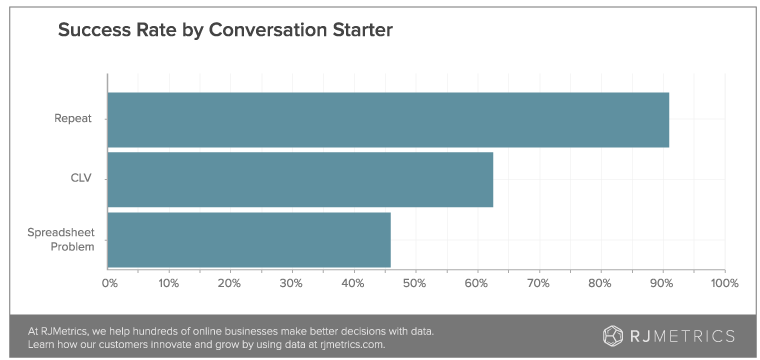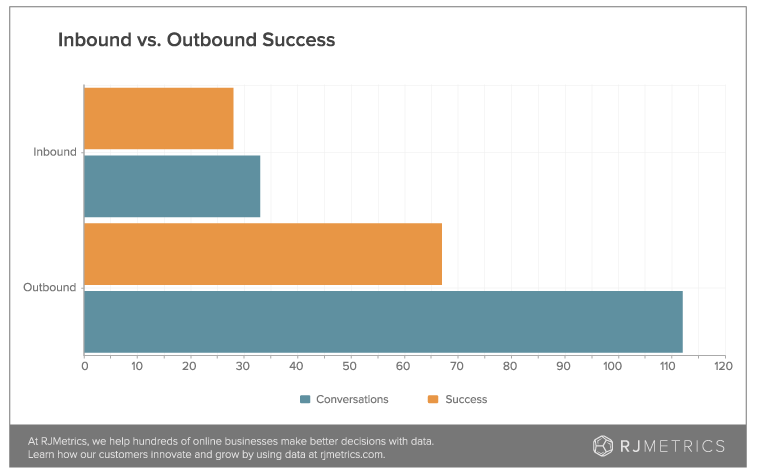In the online world, conversion rate optimization experts think of website traffic as a resource: every visitor represents an opportunity for the company to learn and get better. This rigor is a natural fit for the data-rich world of online marketing, but very few marketers apply the same thinking to their offline marketing.
While data collection offline takes a bit more effort, the same logic applies. Visitors at offline events are a resource, an opportunity to learn and get better. Every event that you attend is an opportunity for you to test something new, learn about your prospects, and gather a new data point that will help you extract more ROI from your next event sponsorship. Tradeshows are a serious investment for B2B marketers, don’t leave your lead generation to luck.
How it’s worked for us
Back in 2011, Bob and Jake (RJMetrics’ co-founders), attended their very first tradeshow. At first they did what they saw other vendors doing: standing, smiling politely, and waiting for interested prospect to strike up a conversation. It was still the early days of the company and the $8,000 price tag was weighing heavily on their minds. They decided that what everyone else was doing wasn’t enough; there had to be a better way to get more leads.
What they learned at that first event has sparked something of a tradition here at RJMetrics. Today we treat conferences like we do any marketing investment. We test, we collect data, and we optimize for increased conversions.
Get ready, you’re about to learn the secret on how to apply conversion rate optimization thinking to your offline marketing efforts.
1. Define your conversion funnel
Behind every macro conversion (a new customer) is a series of micro-conversions (downloading a whitepaper, signing up for a demo). Having a defined funnel on your website is incredibly useful in spotting where you’re gaining and losing customers, and the same trick applies offline as well.
We’ve broken our tradeshow funnel into three steps:
- The conversation – To be successful in online marketing you have to get people to your website. To be successful offline you have to get people to start talking to you. At this part of the funnel we measure success based on one thing: were we successful in getting a person stop and talk to us?
- The pitch – The purpose of these conversations isn’t to chat about the weather or the event. Your conversation starters should be crafted to set you up to talk about how you help companies be successful. Here we measure success on whether or not the person expressed an interest in hearing a short pitch about what we do?
- The meeting – Every good landing page has a clear call-to-action (CTA). Offline, the CTA is asking to set up a meeting. If the pitch grabs the person’s interest it’s time to make the ask “Hey, can I get some time on your calendar to give you a demo of our software?” Success here is measured by whether you can get the person to commit to a time slot for a follow-up call.
Your funnel might be different. For example, you could show people a demo of your product or conduct a free 20 minute consultation, either of these could be its own step in the funnel.
2. A/B test your conversation starters
If you want to get more leads at a conference, you have to start more conversations. Seriously, that’s all it is. The more conversations you start, the more badges you’ll scan, and the more leads you’ll get. The best way to start more conversations is to take an outbound (approach attendees) versus inbound (wait for them to ask a question) approach.
At an event earlier this year, we more than doubled the number of successful conversations we had by adopting an outbound approach:

So, how do you start these conversations? Because we’re data nerds who want to test everything, we have predefined conversation starters that everyone on the team uses, usually we rely on about 3-4 unique starters. This is essentially an A/B/C test that allows us to measure what kinds of messages are working best. Using this approach, here’s what we’ve learned so far about what makes a good conversation starter:
- Start with a question
- Use open-ended questions, if it’s yes or no people will just give their answer and keep on walking
- Ask something relevant to your business
We’ve historically relied heavily on the starter “What’s your customer lifetime value?” This works well for us because customer lifetime value is something that every online business knows they should be measuring, but it’s hard to do. The question often makes attendees chuckle a bit, but also gives them a quick way to disqualify themselves with if they’re, for example, an HR person. Put some thought into your questions, but don’t obsess about it. Just collect data, and iterate for the next event.
3. Collect data
Data collection online is easy. Tools like Optimizely and Unbounce have significantly reduced the barrier to entry of A/B testing. In the offline world, you’ll have to be far more intentional. If you’re at an event that doesn’t have internet access, you’ll want to have a spreadsheet set up to record your data. If you have internet access, Google Forms are the way to go. They’re great for several reasons:
- Everyone on the team can access this via their phone. Conversations move quickly. You want minimal time dedicated to data entry.
- Google forms automatically attach the person’s name and a timestamp to the data. This gives you two additional variables to look at without any additional data entry.
The data you need to gather here is:
- The conversation starter line used
- Conversion data: Were you able to start the conversation? What’s the conversion rate from conversation to pitch? What’s the conversion rate from pitch to meeting?
Some additional variables you could include:
- The person starting the conversation
- Size of the group approached
- Time of day – which Google Forms automatically includes (win!)
4. Measure and learn
Once you’ve got all that data collected, it’s time for the fun stuff. You’ve got your dataset, it’s time to fire up your spreadsheet, or (WARNING: Shameless plug!) do what we do and load this into RJMetrics for analysis.
There are a few things we always look for. First, and most importantly, what conversation starters converted into successful conversations? At an event earlier this year we used a question about repeat purchases, the first conversation starter to unseat the starter about customer lifetime value!

Depending on the size of the event, you’ll want to track your success rates through the funnel.
Time of day is another useful variable to analyze. At our last event, happy hour was held in the exhibit hall at the end of every night, and we noticed spikes in conversations happening in the hour leading up to happy hour. There were fewer people in the exhibit hall, but the people there were ready to chat. This is a good tidbit to know for next year’s event.

Optimize your next event
Until now, we’ve focused largely on using this approach to perfect how we start conversations, but, the application is broad. For example, you could test two case studies against each other to see which story drives engagement. You could offer attendees a demo or a consultation and see which approach is more effective at driving conversions to meetings.
You’ll never have the same volume of offline traffic that you can get online, but that’s no excuse for passing on the opportunity to learn. Every interaction with a prospect, regardless of the medium, is a chance for you to hone your craft.

 Tweet This
Tweet This